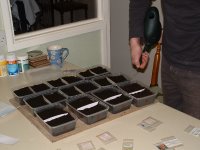Day 9 - What To Do With Them All?

I am blogging my attempt to grow chilli peppers from seeds bought on eBay.

Here is a list of the seed types I've sown this year. Some are the same, but bought from different sources. The box numbers are also detailed for reference.
1A Prairie Fire1B Tabasco2A Hot Banana2B Thai Bangkok Upright3A Habanero Red3B Purple Tiger4A Rocoto Yellow4B Early Jalapeno5A Scotch Bonnet5B Tepin6A Habanero Orange6B Serrano7A Jalapeno7B Scotch Bonnet Red8A Cayenne Long Thin8B Habanero Orange9A Cayenne Hot9B Ancho 10110A Anaheim10B *Unknown variety
 in. Last year I used one seed tray which I covered with a pane of glass to keep the humidity in the soil. This seemed to work fine, but in 2006 I plan to sow even more seeds that in 2005, in the hope that I'll be able to select even healthier seedlings for re-potting later. So, at my mother's suggestion, I used some cheapo Tupperware style containers that I had once bought for use in my camper van, but had been sat in her cupboard for years. The good thing with these is that I have plenty of them and that they each come with their own lid - ideal for retaining humidity after watering.
in. Last year I used one seed tray which I covered with a pane of glass to keep the humidity in the soil. This seemed to work fine, but in 2006 I plan to sow even more seeds that in 2005, in the hope that I'll be able to select even healthier seedlings for re-potting later. So, at my mother's suggestion, I used some cheapo Tupperware style containers that I had once bought for use in my camper van, but had been sat in her cupboard for years. The good thing with these is that I have plenty of them and that they each come with their own lid - ideal for retaining humidity after watering. with a cardboard divider, and then watered the soil. I then took care to label each pot, in large indelible ink, with the number of the container and the variety of the seeds that I intended to plant there. Details of the chilli varieties can be found in the next post.
with a cardboard divider, and then watered the soil. I then took care to label each pot, in large indelible ink, with the number of the container and the variety of the seeds that I intended to plant there. Details of the chilli varieties can be found in the next post.
| Sweet Bell Peppers | None | |
| Anaheim | 100-1000 Scoville Units | |
| Ancho, Prairie Fire | 1000 - 1500 Scoville Units | |
| 1500 - 2500 Scoville Units | ||
| Jalapeno | 2500 - 5000 Scoville Units | |
| Serrano, Hot Banana, Thai Bangkok | 5000 - 15000 Scoville Units | |
| Purple Tiger | 15000 - 30000 Scoville Units | |
| Cayenne, Tabasco | 30000 - 50000 Scoville Units | |
| Rocoto, Tepin | 50000 - 100000 Scoville Units | |
| Habanero, Scotch Bonnet | 100000 - 350000 Scoville Units | |
| Red Savina Habanero | 350-855000 Scoville Units | |
The name of this plant bears no relation to Chile, the country, which is named after the Quechua word chin ("cold"), tchili ("snow"), or chilli ("where the land ends"). Chile is one of the Spanish-speaking countries where chillies are known as aji.
Hi again.
